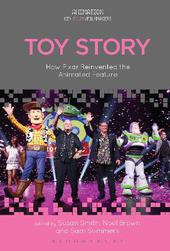
|
Toy Story: How Pixar Reinvented the Animated Feature
Hardback
Main Details
| Title |
Toy Story: How Pixar Reinvented the Animated Feature
|
| Authors and Contributors |
Edited by Susan Smith
|
|
Edited by Noel Brown
|
|
Edited by Sam Summers
|
| Series | Animation: Key Films/Filmmakers |
|---|
| Physical Properties |
| Format:Hardback | | Pages:256 | | Dimensions(mm): Height 229,Width 152 |
|
| Category/Genre | Animated films |
|---|
| ISBN/Barcode |
9781501324918
|
| Classifications | Dewey:791.4372 |
|---|
| Audience | | General | | Tertiary Education (US: College) | | Professional & Vocational | |
|---|
|
Publishing Details |
| Publisher |
Bloomsbury Publishing Plc
|
| Imprint |
Bloomsbury Academic USA
|
| Publication Date |
25 January 2018 |
| Publication Country |
United States
|
Description
This book is available as open access through the Bloomsbury Open Access programme and is available on www.bloomsburycollections.com. Toy Story (John Lasseter, 1995), Pixar's first feature-length production and Hollywood's first completely computer-generated animated film, is an international cultural phenomenon. This collection brings together a diverse range of scholars and practitioners who together explore the themes, compositional techniques, cultural significance and industry legacy of this landmark in contemporary cinema. Topics range from industrial concerns, such as the film's groundbreaking use of computer generated imagery and the establishment of Pixar as a major player in the animation world, to examinations of its music, aesthetics, and the role of toys in both the film and its fandom. The Toy Story franchise as a whole is also considered, with chapters looking at its cross-generational appeal and the experience of growing up alongside the series. As the first substantial work on this landmark film, this book will serve as an authoritative introduction for scholars, students and fans alike.
Author Biography
Susan Smith is Reader in Film Studies at the University of Sunderland, UK. She is author of Elizabeth Taylor (BFI/Palgrave, 2012), Voices in Film (Wallflower Press, 2007), The Musical: Race, Gender and Performance (Columbia University Press, 2005) and Hitchcock: Suspense, Humour and Tone (BFI, 2000). She also co-edits the BFI's Film Stars series. Noel Brown is a Lecturer in Media and Communication at Liverpool Hope University, UK. He is author of The Hollywood Family Film (2012), British Children's Cinema (2016), The Children's Film (2017) and Contemporary Hollywood Animation (forthcoming), and is co-editor of Family Films in Global Cinema (2015). Sam Summers is a researcher at the Centre for Research in Media and Cultural Studies at the University of Sunderland, UK. His research focuses on the use of intertextual references in contemporary animation and DreamWorks' animation in general, with a view to contextualising and historicising the studio's role in the development of the medium.
ReviewsSmith, Brown, and Summers' Toy Story examines Toy Story the film as a work of art, a cultural phenomenon, an industry game changer, and as beloved movie. In illuminating both how - and why - Toy Story is one of the most successful films of all time, this volume, like its namesake, is destined to become a classic. * Amy M Davis, Lecturer in Film and Animation History, The University of Hull, UK * Toy Story is a remarkable film for so many reasons, but the essays collected here place particular emphasis on its fascinating (and highly successful) blending of innovation and convention. By positioning it in relation to diverse continuities and changes in filmmaking, animation, storytelling, music, and art, ultimately the book serves as a kaleidoscopic exploration of the movie's enduring resonance and influence. * Richard McCulloch, Lecturer in Film and Cultural Studies, Centre for Participatory Culture, University of Huddersfield, UK * Toy Story the volume, like Toy Story the movie, offers many pleasures. Its discussions of Pixar's expressive textures, of the new animator as a kind of puppet master, of the cultural meanings of toys, and of the value, even subtlety possible in computer animation are both intellectually satisfying and welcome additions to animation scholarship. But many of these contributions also come with a clearly felt, almost emotional appreciation for what is demonstrably a great film and a testimony to what animation can accomplish. This book fully appreciates that film and, in turn, deserves to be appreciated. * J. P. Telotte, Professor Film and Media Studies, Georgia Institute of Technology, USA *
|